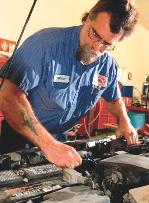
SLAB Exports Rule Targets Labeling Practices
- By Chris Bryant
- Aug 16, 2010
Every driver in the United States produces a type of toxic waste that has a good chance of ending up in a developing country. That waste, in the form of spent lead-acid batteries (SLABs), contains lead compounds and sulfuric acid that, unless properly managed and recycled, can contaminate the air, water, and soil.
The good news is that roughly 95 percent of these batteries are being recycled. The question is, where? Unfortunately, government data suggest that spent batteries are being illegally exported to developing nations with weak or non-existent environmental standards because such regulatory conditions make recycling costs lower. As a result, state-of-the-art U.S. smelting facilities that have the capacity to safely recycle these batteries are underutilized.
On July 7, 2010, a new U.S. Environmental Protection Agency regulation governing battery exports went into effect. While exporting SLABs is not unlawful, very specific requirements are in place to ensure that SLABs are properly handled and transported. The rule makes the labeling of intact batteries as "lead waste" or "scrap" illegal. This has been a practice common among some exporters that have tried to sidestep the stricter regulations and higher costs of exporting hazardous wastes.
The regulations require exporters to notify EPA in advance of exportation to obtain the importing country’s consent – a process that can be time-consuming and costly. Because the United States is not a party to the Basel Convention, these requirements are necessary to export hazardous wastes to countries that have ratified the agreement. Export requests must be submitted at least 45 days in advance, but it can take much longer for receiving countries to grant approval, which may fuel efforts to circumvent existing regulations.
EPA’s new regulations are the first step in a series of efforts to gain control over the illegal exportation of SLABs, which in recent years has become a burgeoning “black market.”
This illegal activity exists not because of a lack of will but due to a gap in compliance and enforcement. Although exporters were required to file hazardous waste export requests prior to July, there were few, if any, records of export notifications. This fact, coupled with industry data that indicate a large number of SLABs are leaving the United States, signifies an inconsistency and invites concern that the majority of these exports are being illegally mislabeled as "lead scrap" or "waste."
Data from the U.S. Department of Commerce suggest that 78 percent of the lead scrap being exported actually consists of spent batteries. Of that amount, the majority is being exported to Mexico with the remaining ending up in Canada, India, China and South Korea. A widely accepted industry estimate indicates that overall, a whopping 260,000 metric tons, or a half a billion pounds, of SLABs will be exported from the United States in 2010.
Although the United States has the capacity to recycle each and every spent battery, the illegal exportation continues, costing jobs and threatening to harm foreign environments and populations. Lead smelters in the United States are among the cleanest in the world, constantly improving technology and processes to achieve increasingly tighter emission limits. New technology already installed at some U.S. smelters has drastically minimized employee exposure to air contaminants, addressing one of the industry’s last remaining health concerns.
While the domestic battery recycling industry is the successful result of an established recycling infrastructure, advanced technology and strict emission standards, developing countries remain at risk for worker exposure and environmental contamination because of lax enforcement standards. A fast growing number of U.S. battery exports are reclaimed in Mexican facilities that fall far short of U.S. technology and emission controls. The case of Metales y Derivados, in Tijuana, Mexico is an example of how a recycling facility operating in a lax regulatory environment can cause significant damage to workers, their families and the community. Only in January, after16 years and the combined efforts of the Mexican and American governments was the toxic waste site finally cleaned up. Although recycling SLABS domestically supports U.S. jobs and is safer and cleaner, it is more profitable for battery exporters to ship batteries to Mexico and other countries. Adding insult to injury, once secondary lead has been reclaimed, the refined Mexican lead is then sold back to U.S. manufacturers, where the lead is incorporated in the batteries that U.S. consumers place in their autos.
Despite EPA’s best efforts, it will likely require a transnational, multi-agency effort to eliminate the problem. More regulation and improved coordination along the borders, including a bi-national hazmat tracking system, will be critical components of a comprehensive plan that ultimately puts a stop to the illegal exportation of SLABs.
Domestic battery reclamation is one of the great recycling success stories in the United States today. Given current domestic capacity and advanced technology, there is no good reason for the export of SLABs to other countries to continue. Perhaps more importantly, as a nation we have a moral obligation to use existing, state-of-the-art technology already in place take care of our own waste, instead of allowing it to threaten the environments of other countries.
About the Author
Chris Bryant is with Bergeson & Campbell, P.C. He has more than 20 years of experience in environmental, health and safety compliance and legislative, regulatory and policy issues. Previously, he was the managing director of the Chemical Products and Technology Division at the American Chemistry Council. Bryant consulted General Electric on EHS matters and was president of The Technical Group, LLC, which specialized in hazardous substance and OSHA matters.